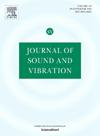基于梁耦合振动的局部缺陷评价方法
IF 4.3
2区 工程技术
Q1 ACOUSTICS
引用次数: 0
摘要
本研究开发并验证了一种利用梁耦合局部模态检测局部结构缺陷的创新方法,该方法将振动限制在目标区域,并且对结构特性的变化保持敏感,同时不受外部边界条件的影响。该方法通过在主结构上附加一个小的辅助梁来创建梁耦合的局部模态,从而通过局部模态分析来精确识别缺陷。测量了该模态的耦合波长和共振频率,并用于确定直接反映缺陷存在和严重程度的局部弯曲刚度。理论建模利用欧拉-伯努利梁理论来预测振动特性,重点关注结构特性改变时特定频率下局部模态的出现。通过有限元方法进行的数值模拟突出了对外部边界刚度变化的鲁棒性及其对局部变化的敏感性。采用系统引入缺陷的梁结构进行的实验验证进一步证实了该方法在精确量化局部刚度变化方面的有效性。与现有的基于模态的方法相比,该方法消除了复杂的信号处理和昂贵的实验设置的需要,使其成为结构健康监测的一种实用且经济的替代方法。所提出的方法不受边界条件变化影响的能力以及隔离局部缺陷的能力增强了其在各种工程应用中可靠的结构完整性评估的适用性。本文章由计算机程序翻译,如有差异,请以英文原文为准。
Localized defect evaluation method based on beam-coupled vibration
This study develops and validates an innovative method for detecting localized structural defects using beam-coupled local modes, which confine vibration to targeted areas and remain sensitive to changes in structural properties while unaffected by external boundary conditions. The proposed method creates a beam-coupled local mode by attaching a small auxiliary beam to the host structure, allowing for precise defect identification through localized modal analysis. The coupled wavelength and resonance frequency of this mode are measured and used to determine local bending stiffness, which directly reflects the presence and severity of defects. Theoretical modeling leverages Euler-Bernoulli beam theory to predict vibrational characteristics, focusing on the emergence of local modes at specific frequencies when structural properties are altered. Numerical simulations conducted via the finite element method highlight robustness against changes in external boundary stiffness and its sensitivity to localized changes. Experimental validation using beam structures with systematically introduced defects further confirms the effectiveness of the method in accurately quantifying localized stiffness variations. Compared to existing modal-based methods, the proposed method eliminates the need for complex signal processing and expensive experimental setups, making it a practical and cost-effective alternative for structural health monitoring. The ability of the proposed method to remain unaffected by boundary condition variations and its capability to isolate localized defects enhance its applicability for reliable structural integrity assessments across diverse engineering applications.
求助全文
通过发布文献求助,成功后即可免费获取论文全文。
去求助
来源期刊

Journal of Sound and Vibration
工程技术-工程:机械
CiteScore
9.10
自引率
10.60%
发文量
551
审稿时长
69 days
期刊介绍:
The Journal of Sound and Vibration (JSV) is an independent journal devoted to the prompt publication of original papers, both theoretical and experimental, that provide new information on any aspect of sound or vibration. There is an emphasis on fundamental work that has potential for practical application.
JSV was founded and operates on the premise that the subject of sound and vibration requires a journal that publishes papers of a high technical standard across the various subdisciplines, thus facilitating awareness of techniques and discoveries in one area that may be applicable in others.
 求助内容:
求助内容: 应助结果提醒方式:
应助结果提醒方式:


